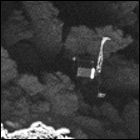Finding Philae
 With mere weeks left before the European Space Agency’s Rosetta space probe is shut down, the spacecraft’s gradually decreasing orbit allows it to see more fine detail on the surface of Comet 67P/Churyumov–Gerasimenko, which is now outbound near the orbit of Jupiter. Rosetta’s surface survey finally reveals the fate of the short-lived Philae lander: as ESA engineers suspected in 2014, it came to rest on its side in a crevasse, preventing its batteries from recharging via its solar panels. Originally aimed at the Agilkia region on the larger of Comet 67P’s two “lobes”, Philae’s harpoon anchoring system failed to fire, leaving the lander to bounce helplessly into a ravine on the smaller lobe of the comet, in the Abydos region. It only relayed its surface findings to Rosetta for three days in late 2014. Rosetta would soon join Philae on the surface, with a surface impact scheduled for September 30, 2016.
With mere weeks left before the European Space Agency’s Rosetta space probe is shut down, the spacecraft’s gradually decreasing orbit allows it to see more fine detail on the surface of Comet 67P/Churyumov–Gerasimenko, which is now outbound near the orbit of Jupiter. Rosetta’s surface survey finally reveals the fate of the short-lived Philae lander: as ESA engineers suspected in 2014, it came to rest on its side in a crevasse, preventing its batteries from recharging via its solar panels. Originally aimed at the Agilkia region on the larger of Comet 67P’s two “lobes”, Philae’s harpoon anchoring system failed to fire, leaving the lander to bounce helplessly into a ravine on the smaller lobe of the comet, in the Abydos region. It only relayed its surface findings to Rosetta for three days in late 2014. Rosetta would soon join Philae on the surface, with a surface impact scheduled for September 30, 2016.